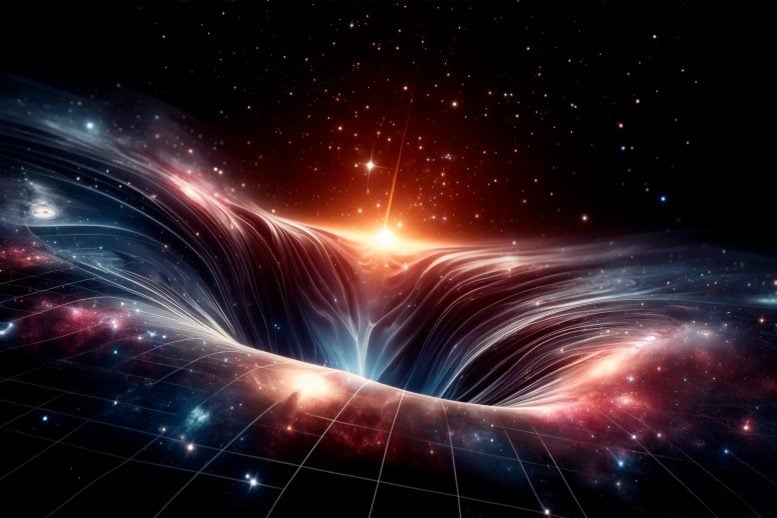
Researchers propose a modification to Einstein’s theory of general relativity, suggesting a “cosmic glitch” that makes gravity slightly weaker across vast cosmic distances. This adjustment could help explain some unaccounted phenomena in the universe. Credit: SciTechDaily.com
Moving one step closer to understanding mysteries at the edge of the universe.
A group of researchers at the University of Waterloo and the University of British Columbia have discovered a potential “cosmic glitch” in the universe’s gravity, explaining its strange behavior on a cosmic scale.
For the last 100 years, physicists have relied upon Albert Einstein’s theory of “general relativity” to explain how gravity works throughout the universe. General relativity, proven accurate by countless tests and observations, suggests that gravity impacts not simply three physical dimensions but also a fourth dimension: time.
“This model of gravity has been essential for everything from theorizing the Big Bang to photographing black holes,” said Robin Wen, the lead author on the project and a recent Waterloo Mathematical Physics graduate.
Challenges at Cosmic Scale
“But when we try to understand gravity on a cosmic scale, at the scale of galaxy clusters and beyond, we encounter apparent inconsistencies with the predictions of general relativity. It’s almost as if gravity itself stops perfectly matching Einstein’s theory. We are calling this inconsistency a ‘cosmic glitch’: gravity becomes around one percent weaker when dealing with distances in the billions of light years. “
For more than twenty years, physicists and astronomers have been trying to create a mathematical model that explains the apparent inconsistencies of the theory of general relativity. Many of those efforts have taken place at Waterloo, which has a long history of cutting-edge gravitational research resulting from ongoing interdisciplinary collaboration between applied mathematicians and astrophysicists.
Historical Context and Research Efforts
“Almost a century ago, astronomers discovered that our universe is expanding,” said Niayesh Afshordi, a professor of astrophysics at the University of Waterloo and researcher at the Perimeter Institute.
“The farther away galaxies are, the faster they are moving, to the point that they seem to be moving at nearly the speed of light, the maximum allowed by Einstein’s theory. Our finding suggests that, on those very scales, Einstein’s theory may also be insufficient.”
Modifying Einstein’s Theory
The research team’s new model of a “cosmic glitch” modifies and extends Einstein’s mathematical formulas in a way that resolves the inconsistency of some of the cosmological measurements without affecting existing successful uses of general relativity.
“Think of it as being like a footnote to Einstein’s theory,” Wen said. “Once you reach a cosmic scale, terms and conditions apply.”
“This new model might just be the first clue in a cosmic puzzle we are starting to solve across space and time,” Afshordi said.
The study, “A cosmic glitch in gravity,” appears in the Journal of Cosmology and Astroparticle Physics.
Reference: “A cosmic glitch in gravity” by Robin Y. Wen, Lukas T. Hergt, Niayesh Afshordi and Douglas Scott, 20 March 2024, Journal of Cosmology and Astroparticle Physics.
DOI: 10.1088/1475-7516/2024/03/045








Given the vast scale of the universe, a one percent discrepancy in gravity measurements across billions of light years seems rather insignificant.
Not a good time to mention the amazing dark matter crutch, or that gravity obviously should follow a flux-rule despite all the intellectually cancerous royal flacking GR garners.
Nobody has a more realistic, obvious and practical gravity theory improvement than the one giving cold nucleons a gravitational retro-reflectivity in order to best explain the roughly octahedral shapes of “rubble pile asteroids” Bennu and Ryugu. That would be a big unappreciated factor in gravitational entanglements, affecting identical masses spinning at the same rate on the same axis most.
In 2012 I uploaded my first low budget video of a lay at-home gravity demonstration of the true nature of gravity using rotating wheels to YouTube; two others since; now on Odysee dot com (e.g., “1Gravity:” https://odysee.com/@charlesgshaver:d/1Gravity:8). Simply put, beginning with the misinterpretation of the scattering of dots in double-slit experiments, as brilliant as Einstein was with energy and matter he erred about space-time and gravity. Coherent pulsing angular lines of gravity force are induced in all matter to radiate across the universe in accordance with the inverse square law of attraction and density by some still unidentified higher force, with rotation intensifying the effect. Photons are affected by individual lines of gravity force once emitted by their sources. Consequently, I believe, they accelerate (blue shift) as they depart their sources and decelerate (red shift) when arriving in our local solar-planetary field of gravity, giving the false impression of a more rapidly expanding universe and to the rise of theoretical dark energy and dark matter to explain that misinterpretation of cosmic proportions. Therefore, the age and size of the universe still need to be determined.
As I see it there are two basic forms of flow relevant to gravity, namely dispersive and nondispersive, with nondispersive flows being 1-D flows and dispersive flows being significantly 2-D-favoring (largely sheetlike) in the case of an ordered spinning mass and 3-D for a chaotic mass. Nonlocality seems to have elements of joining masses with twisted sheets, the tighter the twist the firmer the coupling. Some sort of extended couplings with light-like modes also seems essential to gravitational entanglement. If strings are meaningful, vacuum fields seem to best describe mass-less reduced-dimension images of string actions.
Non-dispersive gravitational flows would be cooled matter in naturally filamentary flows, in that case. These flows would be natural locations for DM filament effects.
Two-dimensional gravitational features would be cooling-matter flow features. A filamentary tendency of spinning cooled small masses to tip their spin axes 90 degrees in coupling to a dominant external spin system will assist this. These flows would be natural locations for ringlike DM effects.
There are many ways to interpret typical 1-D velocity profiles when applied to spirals, fwiw. Of course, wherever there is a DM effect there should be matter cosmologically nearby and if galaxy is energetic, spread-out and randomly disordered enough then a natural origin for “halo”-like effects.
I prefer to focus on a ringlike gravitational halo structure, much like MOND people do, and the model is lensing-centric and extends naturally to larger (cluster-scale) lensing rings, such as through wave-mixing and 2-level particle rescaling, whereas MOND remains clueless about lensing.
“The farther away galaxies are, the faster they are moving, to the point that they seem to be moving at nearly the speed of light, the maximum allowed by Einstein’s theory. Our finding suggests that, on those very scales, Einstein’s theory may also be insufficient.”
In view of recent announcements of a new time-domain redshift measurement technique for quasars, this appears to be yet another way for public science outreach staff to admit, without being too obvious about it, that gravitational time dilation is actually nothing more than gravitational photon dilation.
Gravity, spacetime curvature and matter are still open to be explored though Einstein established relation ship of these states in an assumed isotropic conserved domain of Universe. Universe is not in the way the fundamental assumption brings in. Roughly a region of one billion light years in thickness may satisfy Einstein equations and the current value of gravity but beyond that it changes significantly as the volume acceleration changes and matter energy changes. The 21 st century thinkers may break away from old thoughts and light a lamp soon. Also the concept of force fields and much contrived efforts of connecting quantum gravity to other fields need to be changed. Do we get the complete list of fields in which we are existing by narrating the four items alone, dont we have to find the super structure of field generators which smoothly runs down from strong force to gravitational force with an incredible scaling of 10 ^ -38 value? Will the fundamental particle list be placed in that order and rationalise our knowledge to a revolutionary level? Will the whole energy of whole fields including the ones that are unknown today and that are manifested only through unexplained phenomenon, add up to a total back ground field energy producing Higgs values? Hope a new revelation of Universe structure and all the above revolutionary concepts solve the puzzle of gravity and rationalise it with other forces soon, bringing in a new light in the darkness of repetitive science thoughts and commercial discussions of no progressive value. The need of a new universe is a necessity, if JWST observation till now, need to be ratified and futuristic high resolution high depth exploration that we may need to be carried out. A Series of new generation Nobel Prizes await all of you who can dive in to this.
Multi dimensional entities require fuel. Reality is sucking up the vacuum mass causing the curvature.
I’m either insane or way ahead of my time.
Good article. My dilemma is why do galaxies farther away from us (i.e. the solar system) seem to move faster than those nearer us?